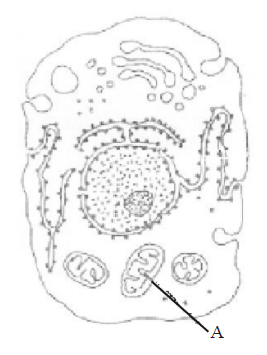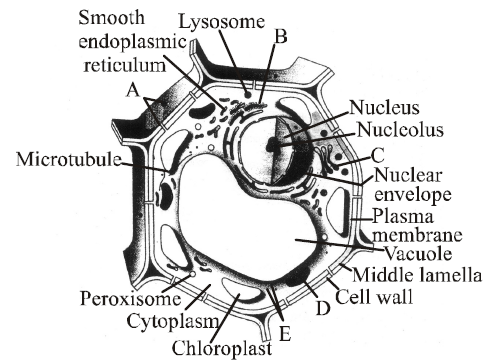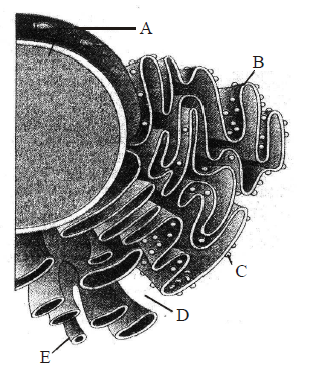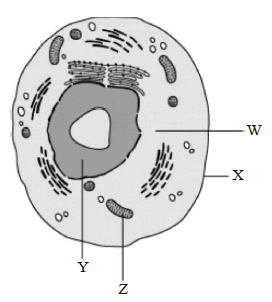Cell - the unit of life 1000+ MCQ with answer for ISRO Recruitment
Thursday 9th of March 2023

Sharing is caring
1. The membrane of the erythrocytes has approximately ___% of proteins and ___% lipids.
A. 42, 50
B. 52, 40
C. 50, 50
D. 60, 40
Answer : B
A. 42, 50
B. 52, 40
C. 50, 50
D. 60, 40
Answer : B
2. Which of the following cell organelles were discovered after the introduction of electron microscope?
A. Mitochondria
B. Endoplasmic reticulum
C. Ribosomes
D. Both (b) and (c)
Answer : D
A. Mitochondria
B. Endoplasmic reticulum
C. Ribosomes
D. Both (b) and (c)
Answer : D
3. A student placed two cells in the same solution in two different containers. The observation was given in the table.
Which structure maintains the shape of the cell present in container 2 and provides the most significant difference between the two cells?
A. Nucleus
B. Cell wall
C. Chloroplast
D. Cell membrane
Answer : B
| Container | Observation |
|---|---|
| 1 | Cell burst |
| 2 | Cell does not change its shape |
Which structure maintains the shape of the cell present in container 2 and provides the most significant difference between the two cells?
A. Nucleus
B. Cell wall
C. Chloroplast
D. Cell membrane
Answer : B
4. In the given figure of animal cell, one orginelle is marked as A. Select the correct identification and function of the organelle A from the given option.

A. Endoplasmic reticulum Synthesis of lipids.
B. Mitochondria Produce cellular energy in the form of ATP.
C. Golgi body Provides packaging material.
D. Lysosomes Secrete hydrolytic enzymes.
Answer : B

A. Endoplasmic reticulum Synthesis of lipids.
B. Mitochondria Produce cellular energy in the form of ATP.
C. Golgi body Provides packaging material.
D. Lysosomes Secrete hydrolytic enzymes.
Answer : B
5. The following diagram shows some of the missing structures in a plant cell marked as A, B, C, D E. Choose the option with their correct names.

A. A - Plasmodesmata, B - Rough endoplasmic reticulum, C - Golgi apparatus, D - Mitochondrion, E - Ribosomes
B. A - Desmosome, B - Rough endoplasmic reticulum, C - Golgi apparatus, D - Mitochondrion, E - Ribosomes
C. A - Plasmodesmata, B - Smooth endoplasmic reticulum, C - Golgi apparatus, D - Mitochondrion, E - Ribosomes
D. A - Tight junction, B - Rough endoplasmic reticulum, C - Golgi apparatus, D - Mitochondrion, E -Ribosomes
Answer : A

A. A - Plasmodesmata, B - Rough endoplasmic reticulum, C - Golgi apparatus, D - Mitochondrion, E - Ribosomes
B. A - Desmosome, B - Rough endoplasmic reticulum, C - Golgi apparatus, D - Mitochondrion, E - Ribosomes
C. A - Plasmodesmata, B - Smooth endoplasmic reticulum, C - Golgi apparatus, D - Mitochondrion, E - Ribosomes
D. A - Tight junction, B - Rough endoplasmic reticulum, C - Golgi apparatus, D - Mitochondrion, E -Ribosomes
Answer : A
6. Match column-I with column-II and select the correct option.
A. A - IV, B - V, C - I, D - II
B. A - I, B - II, C - IV, D - III
C. A - IV, B - I, C - II, D - III
D. A - I, B - II, C - III, D - IV
Answer : A
| Column - I | Column - II |
|---|---|
| A. Golgi apparatus | I. Storage |
| B. Mitochondria | II. Photosynthesis |
| C. Vacuoles | III. Transport |
| D. Grana | IV. Secretion |
| .. | V. Respiration |
A. A - IV, B - V, C - I, D - II
B. A - I, B - II, C - IV, D - III
C. A - IV, B - I, C - II, D - III
D. A - I, B - II, C - III, D - IV
Answer : A
7. Satellite means
A. terminal part of the chromosome beyond secondary constriction.
B. terminal part of the chromosome beyond primary constriction.
C. terminal part of chromosome beyond tertiary constriction.
D. none of the above
Answer : A
A. terminal part of the chromosome beyond secondary constriction.
B. terminal part of the chromosome beyond primary constriction.
C. terminal part of chromosome beyond tertiary constriction.
D. none of the above
Answer : A
8. An organalle devoid of membrane covering is
A. vacuole
B. ribosome
C. peroxisome
D. lysosome
Answer : B
A. vacuole
B. ribosome
C. peroxisome
D. lysosome
Answer : B
9. Which of the following lacks cell wall?
A. Gametes
B. Amoeba
C. Mycoplasma
D. All of these
Answer : D
A. Gametes
B. Amoeba
C. Mycoplasma
D. All of these
Answer : D
10. Plastids storing fat are called
A. Elaioplasts
B. Sphaerosomes
C. Aleuroplasts
D. Pyrenoids
Answer : A
A. Elaioplasts
B. Sphaerosomes
C. Aleuroplasts
D. Pyrenoids
Answer : A
11. Lysosomes contain
A. carbohydrates
B. hormones
C. nucleic acids
D. hydrolases.
Answer : D
A. carbohydrates
B. hormones
C. nucleic acids
D. hydrolases.
Answer : D
12. Most of water, in mature plant cells occurs in
A. nucleus
B. cell wall
C. vacuoles
D. cytoplasm
Answer : C
A. nucleus
B. cell wall
C. vacuoles
D. cytoplasm
Answer : C
13. Which of the following is incorrect ?
A. Mycoplasma is the smallest cell (0.3 �).
B. Bacteria are 3 to 5 �m in size.
C. The largest cell is the egg of an ostrich.
D. Nerve cells are some of the smallest cells.
Answer : D
A. Mycoplasma is the smallest cell (0.3 �).
B. Bacteria are 3 to 5 �m in size.
C. The largest cell is the egg of an ostrich.
D. Nerve cells are some of the smallest cells.
Answer : D
14. Match column-I and column-II and select the correct answer
A. A III; B IV; C II; D I
B. A II; B IV; C III; D I
C. A I; B II; C III; D IV
D. A IV; B III; C I ; D II
Answer : B
| Column-I | Column-II |
|---|---|
| A. Bacteria without walls | I. Lysosome |
| B. Small circular DNA | II. Mycoplasma cells |
| C. Flattened sacs in | III. Thylakoid a chloroplast |
| D. A vesicle in which | IV. Plasmid hydrolytic enzymes are stored |
A. A III; B IV; C II; D I
B. A II; B IV; C III; D I
C. A I; B II; C III; D IV
D. A IV; B III; C I ; D II
Answer : B
15. Match column-I with column-II and choose the correct option.
A. A III; B IV; C II; D I
B. A IV; B III; C II; D I
C. A I; B II; C III; D IV
D. A IV; B III; C I ; D II
Answer : A
| Column-I | Column-II |
|---|---|
| (Chromosome) | (Position of Centromere) |
| A. Metacentric | I. At the tip |
| B. Submetacentric | II. Almost near the tip |
| C. Acrocentric | III. At the middle |
| D. Telocentric | IV. Slightly away from the middle |
A. A III; B IV; C II; D I
B. A IV; B III; C II; D I
C. A I; B II; C III; D IV
D. A IV; B III; C I ; D II
Answer : A
16. Which one of the following structures between two adjacent cells is an effective transport pathway?
A. Plasmodesmata
B. Plastoquinones
C. Endoplasmic reticulum
D. Plasmalemma
Answer : A
A. Plasmodesmata
B. Plastoquinones
C. Endoplasmic reticulum
D. Plasmalemma
Answer : A
A. structurally different but functionally similar.
B. structurally as well as functionally different.
C. structurally similar but functionally different.
D. structurally different but functionally similar.
Answer : B
18. Select the correct match of the types of neuron present in column I with its location given in column II.
A. A - (i), B - (ii), C - (iii), D - (iv)
B. A - (iii), B - (i), C - (ii), D - (iv)
C. A - (iii), B - (i), C - (iv), D - (ii)
D. A - (i), B - (iv), C - (iii), D - (ii)
Answer : B
| Column I | Column II |
|---|---|
| A. Centrioles | (i) Non-membrane bound organelle which helps in cell division |
| B. Fimbriae | (ii) Special structure of bacteria which help them to attach with rocks in stream and also to host tissue |
| C. Endomembrane | (iii) Includes those organelles system whose functions are coordinated |
| D. Mitochondria | (iv) Divide by fission and site of aerobic respiration |
A. A - (i), B - (ii), C - (iii), D - (iv)
B. A - (iii), B - (i), C - (ii), D - (iv)
C. A - (iii), B - (i), C - (iv), D - (ii)
D. A - (i), B - (iv), C - (iii), D - (ii)
Answer : B
19. Which of the following is absent in prokaryotes?
A. DNA
B. RNA
C. Plasma membrane
D. Mitochondria
Answer : D
A. DNA
B. RNA
C. Plasma membrane
D. Mitochondria
Answer : D
20. Golgi apparatus is absent in
A. higher plants
B. yeast
C. bacteria and blue-green algae
D. None of the above
Answer : C
A. higher plants
B. yeast
C. bacteria and blue-green algae
D. None of the above
Answer : C
21. Read the folowing statements and identify the correct option.
A. (i) and (ii)
B. (ii) and (iv)
C. (i), (ii) and (iv)
D. None of the above
Answer : C
- Contractile vacuole takes part in osmoregulation and excretion.
- Food vacuole is formed by engulfing the food particles.
- The vacuole is bound by a double membrane called tonoplast.
- Vacuole can occupy upto 90 percent of the volume of the cell.
A. (i) and (ii)
B. (ii) and (iv)
C. (i), (ii) and (iv)
D. None of the above
Answer : C
22. What would happen if lysosomes get ruptured in a cell?
A. Cell dies
B. Cell shrinks
C. Cell swell up
D. Nothing would happen
Answer : A
A. Cell dies
B. Cell shrinks
C. Cell swell up
D. Nothing would happen
Answer : A
23. Which of the following pair lack the unit membrane?
A. Nucleus and E.R.
B. Mitochondria and chloroplast
C. Ribosome and nucleolus
D. Golgi body and lysosome
Answer : C
A. Nucleus and E.R.
B. Mitochondria and chloroplast
C. Ribosome and nucleolus
D. Golgi body and lysosome
Answer : C
24. Which of the following pair are correctly matched ?
(I) Amyloplasts Store proteins
(II) Mitochondrion Power house of the cell
(III) Stroma Chlorophyll pigment
(IV) Axoneme 9 + 2 array
A. (I) and (III) only
B. (II), (III) and (IV) only
C. (III) and (IV) only
D. (II) and (IV) only
Answer : D
(I) Amyloplasts Store proteins
(II) Mitochondrion Power house of the cell
(III) Stroma Chlorophyll pigment
(IV) Axoneme 9 + 2 array
A. (I) and (III) only
B. (II), (III) and (IV) only
C. (III) and (IV) only
D. (II) and (IV) only
Answer : D
25. Select the statements which are related to Schwann.
A. Only (i)
B. Only (iii)
C. (i) and (iii)
D. All of these
Answer : D
- He reported that cells have a thin outer layer which is today known as plasma membrane
- Cell wall is a unique character of the plant cell.
- Body of plants and animals are composed of cells and products of cells.
A. Only (i)
B. Only (iii)
C. (i) and (iii)
D. All of these
Answer : D
26. Identify the components labelled as A, B, C, D and E in the diagram given below from the list (i) to (viii).

A. A - (viii), B - (v), C - (vii), D - (iii), E - (iv)
B. A - (i), B - (iv), C - (vii), D - (vi), E - (iii)
C. A - (vi), B - (v), C - (iv), D - (vii), E - (i)
D. A - (v), B - (i), C - (iii), D - (ii), E - (iv)
Answer : A

- Cristae of mitochondria
- Inner membrane of mitochondria
- Cytoplasm
- Smooth endoplasmic reticulum
- Rough endoplasmic reticulum
- Mitochondrial matrix
- Ribosome
- Nucleus
A. A - (viii), B - (v), C - (vii), D - (iii), E - (iv)
B. A - (i), B - (iv), C - (vii), D - (vi), E - (iii)
C. A - (vi), B - (v), C - (iv), D - (vii), E - (i)
D. A - (v), B - (i), C - (iii), D - (ii), E - (iv)
Answer : A
27. pH of vacuolar cell sap is
A. neutral and isotonic.
B. alkaline and isotonic.
C. acidic and hypertonic.
D. equal to cytoplasm and isotonic.
Answer : C
A. neutral and isotonic.
B. alkaline and isotonic.
C. acidic and hypertonic.
D. equal to cytoplasm and isotonic.
Answer : C
28. Protein synthesis in an animal cell occurs
A. on ribosomes present in cytoplasm as well as in mitochondria.
B. on ribosomes present in the nucleolus as well as in cytoplasm.
C. only on ribosomes attached to the nuclears envelope and endoplasmic reticulum.
D. only on the ribosomes present in cytosol.
Answer : A
A. on ribosomes present in cytoplasm as well as in mitochondria.
B. on ribosomes present in the nucleolus as well as in cytoplasm.
C. only on ribosomes attached to the nuclears envelope and endoplasmic reticulum.
D. only on the ribosomes present in cytosol.
Answer : A
29. 
Which cellular structure helps in transferring genetic information from one generation to another?
A. W
B. X
C. Y
D. Z
Answer : C

Which cellular structure helps in transferring genetic information from one generation to another?
A. W
B. X
C. Y
D. Z
Answer : C
30. Integral proteins of cell membrane occur on/in
A. inner surfaces
B. outer surfaces
C. phospholipid matrix
D. inner and outer surfaces
Answer : D
A. inner surfaces
B. outer surfaces
C. phospholipid matrix
D. inner and outer surfaces
Answer : D
31. _______________ is the important site of formation of glycoproteins and golycolipids.
A. SER
B. Lysosome
C. Golgi apparatus
D. Mitochondria
Answer : C
A. SER
B. Lysosome
C. Golgi apparatus
D. Mitochondria
Answer : C
32. Which of the following will determines the shape of the cells and provides a strong structural support to prevent the bacterium from bursting or collapsing?
A. Plasmids
B. Cell wall
C. Mesosome
D. Cell membrane
Answer : B
A. Plasmids
B. Cell wall
C. Mesosome
D. Cell membrane
Answer : B
33. 
Which function is carried out by the cell organelle 'X'?
A. helps control the movement of substance in and out of the cell
B. passes information from the parent cell to newly formed cell
C. maintains the proper shape of the cell and serves as a protective barrier
D. helps the cell to make food with the help of chlorophyll and sunlight
Aswer : A

Which function is carried out by the cell organelle 'X'?
A. helps control the movement of substance in and out of the cell
B. passes information from the parent cell to newly formed cell
C. maintains the proper shape of the cell and serves as a protective barrier
D. helps the cell to make food with the help of chlorophyll and sunlight
Aswer : A
34. Match column-I with column-II and select the correct option.
A. A III, B II, C IV, D I
B. A II, B III, C IV, D I
C. A I, B III, C II, D IV
D. A IV, B II, C III, D I
Answer : A
| Column - I | Column - II |
|---|---|
| A. RER | I. Intracellular and extracellular digestion |
| B. Cell wall | II. Provide structural support to the cell |
| C. Flagella | III. Protein synthesis and secretion |
| D. Lysosomes | IV Responsible for cell movement |
A. A III, B II, C IV, D I
B. A II, B III, C IV, D I
C. A I, B III, C II, D IV
D. A IV, B II, C III, D I
Answer : A
35. The main organelle involved in modification and routing of newly synthesized proteins to their destinations is
A. chloroplast
B. mitochondria
C. lysosome
D. endoplasmic reticulum
Answer : D
A. chloroplast
B. mitochondria
C. lysosome
D. endoplasmic reticulum
Answer : D
36. You are asked to examine a cell using a powerful light microscope. The image you see has a clearly defined nucleus and mitochondria. It also has a large central vacuole and chloroplasts. From what group of organisms did this cell most likely come?
A. Bacteria
B. Protists
C. Fungi
D. Plants
Answer : D
A. Bacteria
B. Protists
C. Fungi
D. Plants
Answer : D
37. In which method of transport, plasma membrane does not require carrier molecule?
A. Active transport
B. Facilitated diffusion
C. Simple diffusion
D. Na+ K+ pump
Answer : C
A. Active transport
B. Facilitated diffusion
C. Simple diffusion
D. Na+ K+ pump
Answer : C
38. A component of cytoskeleton is
A. microtubule
B. bone
C. chitin
D. cartilage.
Answer : A
A. microtubule
B. bone
C. chitin
D. cartilage.
Answer : A
39. The lipid component of the membrane mainly consists of __________.
A. polysaccharides
B. phosphoglyceride
C. monosaccharaides
D. both (a) and (c)
Answer : B
A. polysaccharides
B. phosphoglyceride
C. monosaccharaides
D. both (a) and (c)
Answer : B
40. Which of the following statements are correct ?
A. (iii) and (iv)
B. (i) and (ii)
C. (ii) and (iii)
D. (i) and (iv)
Answer : A
- In prokaryotic cells, a special membranous structure formed by the extension of the plasma membrane into the cell is known as polysome.
- The smooth endoplasmic reticulum is the major site for synthesis of glycoproteins.
- RuBisCO is the most abundant protein in the whole biosphere.
- Mitochondria, chloroplasts and peroxisomes are not considered as part of endomembrane system. Of the above statements
A. (iii) and (iv)
B. (i) and (ii)
C. (ii) and (iii)
D. (i) and (iv)
Answer : A
41. Which of the following statement is false?
A. The ribosomes of a polysome translate the mRNA into protein.
B. Mitochondria divide by fragmentation.
C. All cell arise from pre-existing cells.
D. The lipid component of the membrane mainly consists of phosphoglycerides.
Answer : B
A. The ribosomes of a polysome translate the mRNA into protein.
B. Mitochondria divide by fragmentation.
C. All cell arise from pre-existing cells.
D. The lipid component of the membrane mainly consists of phosphoglycerides.
Answer : B
42. The given diagram shows the sectional view of a mitochondrion.

Identify the parts labelled as A, B, C, D & E
A. A - Outer membrane, B - Inner membrane, C - Matrix, D - Inter- membrane space, E - Crista
B. A - Outer membrane, B - Inner membrane, C - Intermembrane space, D - Matrix, E - Crista
C. A - Outer membrane, B - Inner membrane, C - Matrix, D - Crista, E - Inter - membrane space
D. A - Outer membrane, B - Inner membrane, C- Crista, D - Matrix, E - Inter-membrane space
Answer : A

Identify the parts labelled as A, B, C, D & E
A. A - Outer membrane, B - Inner membrane, C - Matrix, D - Inter- membrane space, E - Crista
B. A - Outer membrane, B - Inner membrane, C - Intermembrane space, D - Matrix, E - Crista
C. A - Outer membrane, B - Inner membrane, C - Matrix, D - Crista, E - Inter - membrane space
D. A - Outer membrane, B - Inner membrane, C- Crista, D - Matrix, E - Inter-membrane space
Answer : A
43. Choose the wrong statements regarding bacterial cell
A. (i) and (iii)
B. (i) and (ii)
C. (ii) and (iii)
D. (i) and (iv)
Answer : C
- Glycocalyx is the outermost envelope in bacteria.
- The glycocalyx could be a loose sheath called capsule.
- The glycocalyx may be thick and tough called slime layer.
- A special structure formed by the plasma membrane is called mesosome.
- Small bristle like fibres sprouting out of the cell are called fimbriae.
A. (i) and (iii)
B. (i) and (ii)
C. (ii) and (iii)
D. (i) and (iv)
Answer : C
44. Polysome is a chain of
A. oxysomes
B. sphaerosomes
C. ribosomes
D. dictyosomes
Answer : C
A. oxysomes
B. sphaerosomes
C. ribosomes
D. dictyosomes
Answer : C
45. Function of RER is
A. autolysis
B. protein synthesis
C. lipid synthesis
D. carbohydrate synthesis
Answer : B
A. autolysis
B. protein synthesis
C. lipid synthesis
D. carbohydrate synthesis
Answer : B
46. Which one of the following pairs is not correctly matched?
A. Cristae The tubular structure formed by the folding of the inner membrane of the mitochondrion.
B. Plasmodesmata The membrane surrounding the vacuole in plants.
C. Grana Membrane bound discs in chloroplasts that contain chlorophylls and carotenoids.
D. Middle lamella Layer between adjacent cells walls in plants derived from cell plate.
Answer : B
A. Cristae The tubular structure formed by the folding of the inner membrane of the mitochondrion.
B. Plasmodesmata The membrane surrounding the vacuole in plants.
C. Grana Membrane bound discs in chloroplasts that contain chlorophylls and carotenoids.
D. Middle lamella Layer between adjacent cells walls in plants derived from cell plate.
Answer : B
47. Basal bodies are associated with the formation of
A. phragmoplast
B. cilia and flagella
C. cell plate
D. kinetochore
Answer : B
A. phragmoplast
B. cilia and flagella
C. cell plate
D. kinetochore
Answer : B
48. Active transport across biomembrane involves
A. production of ATP
B. requirement of energy
C. production of toxin
D. release of energy
Answer : B
A. production of ATP
B. requirement of energy
C. production of toxin
D. release of energy
Answer : B
49. Which of the following statement of a bacterial cell is/are correct?
A. (i), (ii), (iii)
B. All of the above
C. (ii) & (iv)
D. None of the above
Answer : A
- Mesosome is formed by the extensions of plasma membrane into the cell.
- The pili are elongated tubular structures made up of a protein.
- Flagellum is composed of filament, hook and basal body.
- Ribosomes are about 30 nm by 50 nm in size.
A. (i), (ii), (iii)
B. All of the above
C. (ii) & (iv)
D. None of the above
Answer : A
50. Centrioles and centrosomes occur in the cells of
A. green plants
B. animals
C. bacteria and cyanobacteria
D. both (b) and (c)
Answer : B
A. green plants
B. animals
C. bacteria and cyanobacteria
D. both (b) and (c)
Answer : B
Sharing is caring
Related Post
1000+ The Living World Multiple Choice Question Answer [Solved]
1000+ Sentence Correction MCQ for CTET [Solved]
1000+ Concrete Technology and Design MCQ for CAT [Solved]
1000+ Error Detection Multiple Choice Question Answer [Solved]
Clause Analysis MCQ Solved Paper for RRB JE
SSC CGL - Relationship based problems 1000+ MCQ [Solved] PDF Download